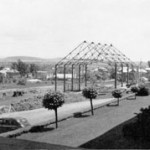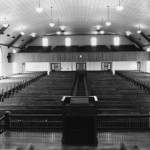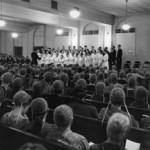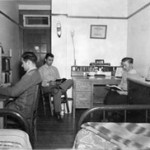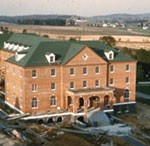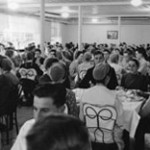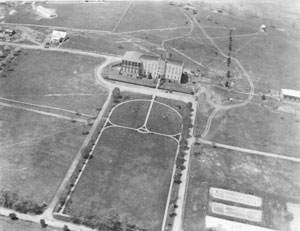
Before Jacob Shenk began to pour resources into the school, Eastern Mennonite was a barren place. He added the north annex to the main building, Lehman Auditorium, and Northlawn dormitory.
Assembly Hall was torn down in 1941, more than 20 years beyond the time when the board acknowledged that it was a fire trap. For decades Eastern Mennonite officials had swallowed their qualms, kept the building patched together, and used it for short-term housing. It was also used for high school classes in woodwork, sheet metal, electricity and farm mechanics.
Also in 1941, a new Industrial Arts Building and north wing to the Ad Building were constructed at a cost of about $70,000 ($990,000 in today’s dollars). The Industrial Arts Building was the fourth building on the site where the current seminary sits. First there was an old barn (EMS’s earliest makeshift gym); second, the toy foundry; third, Suter’s Planing Mill. What does the future hold for the seminary building? Our 90-year history shows that few facilities escape the changes wrought by time.
There were more facility needs in 1941. President Stauffer made a plea for gifts to construct a new, freestanding chapel to replace the large assembly hall used in the Ad Building since 1920. He noted that EMS had outgrown its chapel for the third time since 1917 “under the blessing of God,” and he offered this analogy to prospective donors:
When healthy children outgrow their clothes, parents are interested in providing larger shoes, suits, and coats, even though they do cost more. We would rather pay for larger clothes and more of them, than to have our children remain small, weak, or sickly, and be faced constantly with doctor and hospital bills. We are sure that every bulletin reader would rather see Eastern Mennonite School outgrowing its facilities, than to see a yearly deficit marked against her constituency.
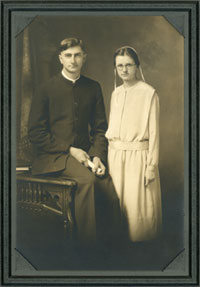
The 1926 wedding photo of Jacob and Lucy Shenk.
Hatchery owner Jacob A. Shenk gave $20,000 ($283,000 in today’s dollars) as seed money for the chapel in 1941. (More on Shenk a few paragraphs further.) Over the next two years, another $70,000 ($895,000 today) was contributed, enabling EMS to complete its chapel during its 25th anniversary year in 1942-43. The chapel eventually was named after Chester K. Lehman, who served Eastern Mennonite for 32 years as dean and 43 years as Bible teacher.
For its 30th birthday in 1947, EMS formally marked the end of its long transition from being a secondary school, to a junior college, to a four-year institution. It assumed the name of Eastern Mennonite College (EMC). A home economics building was placed beside the Industrial Arts Building. The original farmer’s cottage, dating from the days when the campus was a working farm, became the Art Building. (In 1991, all of these buildings would disappear to make way for the seminary.)
EMC faced a major deficit in 1947-48, arising from the expense of moving from being a junior college to being an accredited senior college. Teachers and administrators rose to solve the problem, doing person-to-person solicitations. Several mailed fundraising appeals also yielded results.
Despite its shaky financial status, EMC could not delay building dormitory space. First-year men were living in a poultry shed, literally. “We were on the second floor of the ‘turkey dorm,’ above a hatchery that was still operating,” Dr. Kenton Brubaker recalls of his first autumn in EMC lodging in 1950. “We were all in one room divided by curtained cubicles “maybe 15 to 18 of us.”
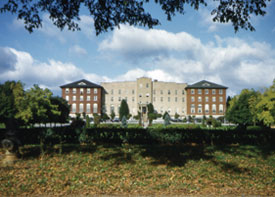
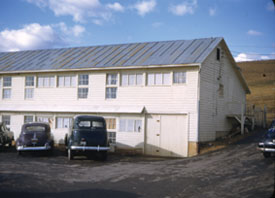
The Ad Building (top) and the “turkey dorm” around 1950 in photos taken by Kenton Brubaker ’54.
The owner of the “turkey dorm,” Jacob Shenk, lent the space to EMC for several years as an emergency measure until a standard dormitory could be constructed. By 1951-52, the turkey dorm was abandoned, with its occupants moving into the “block dorm,” also known as Birchwood, by the EMC park area. (This dorm was torn down in 1988 to make way for building the Parkwoods apartments in 1989.)
Quiet, unassuming Shenk played a decisive role in EMC’s history. He worked part time while studying at EMS from 1920 to 1927, when he graduated from high school as a 27-year-old. (Twenty-something-aged students, attending school as their means permitted, were common in the early decades of EMS.) In 1932, Shenk bought a failing hatchery and built it into one of the most successful chicken businesses in Virginia.
By the 1940s, Shenk was a major source of charitable giving in the Valley. From 1942 until his death in 1950, Shenk channeled 90 percent of his profits into gifts to EMS/EMC, hospitals and Mennonite church work, according to Entrepreneurs in the Faith Community, a 1996 book edited by Calvin W. Redekop and Benjamin W. Redekop. “We are stewards and not owners” of our earnings, said Shenk.
Around 1940-41 Shenk drew up the plans for the north annex and Lehman Chapel. During the 1920s Shenk had taken a drafting course by correspondence and had spent a summer building homes in the nation’s capital. Shenk’s designs were simple, some might say austere: a foundation of local gray-colored limestone blocks, topped by walls of locally produced red brick, covered by shed roofs typical of Shenandoah Valley farm buildings.
Shenk did pick up and repeat the single aesthetic feature visible on the south end of the existing Ad Building: arches above the windows. By the time Shenk designed Northlawn in the late 1940s, he embedded in each brick arch three lighter-colored stones “one at the top and one on each side” in a cruciform shape.
By the spring of 1942, the steel frame of Lehman Auditorium was up. By the fall of 1943, the new chapel was ready to replace the one in the Ad Building (Right).
Virginia Mennonite historian James O. Lehman, who moved from Ohio to enroll as a high school student in 1949, recalls a question that played on his mind after he discovered that EMS somehow gained two extensive structures, the north annex (1942) and Lehman Chapel (1943), amid the austerity of the war years. “Who financed these projects?” The answer to Lehman’s question, he eventually came to realize, was unobtrusive Jacob Shenk – the same man who quietly funded construction for the local hospital and Lindale, Zion, Broad Street and Ridgeway Mennonite churches.
In 1948, the board of trustees authorized “a program of solicitation for the Women’s Dormitory,” later known as Northlawn. The board said construction could begin “as soon as one-fourth of the estimated cost (of $416,000) is donated or pledged and that construction (could) proceed as long as the indebtedness does not exceed one-half the total amount of money subscribed to the project.”
This was an astonishing commitment or, perhaps, leap-of-faith. In today’s dollars, the board was authorizing a possible debt of $1.8 million to build Northlawn, to be recouped from anticipated donations. Of course, at the time there was no reason to believe that Jacob Shenk’s hatchery business, which posted revenue of approximately $1 million in 1949, would not be providing for EMC.
Similar to his chapel role, Shenk was the designer-funder in launching the construction of Northlawn. It was a massive undertaking 59,600 square feet spread over five floors bigger even than today’s Campus Center. The project slowed after Shenk died in 1950 at age 50, when the plane he was piloting malfunctioned and crashed over Tennessee during a mission trip. The Daily News Record reported that 1,600 people attended Shenk’s funeral, filling Lehman Auditorium and its basement, before spilling outside to listen via loudspeaker. It took another seven years to complete Northlawn nine years total of adding one floor at a time, as money permitted, in the absence of a major benefactor like Shenk.
In the book he co-edited, Calvin Redekop printed this response of Jacob’s widow Lucy to the question of how much money her husband gave away: “I don’t know. I can find out, but I won’t. The college got a lot of money, but few if any people knew where it came from.”
By reasonable estimate Jacob donated at least $400,000 and perhaps as much as $500,000 to Eastern Mennonite the equivalent of $4-$5 million in today’s dollars. And this was done during a relatively short period when he was aged 40 to 50. Concurrent with running his business, Shenk served as church deacon, college trustee, Virginia Mission Board president, and member of the building committee of LaJunta Hospital and Nurses Home in Colorado.
The Shenks lived comfortably, but not luxuriously. The home in which they raised two sons and two daughters was a brick bungalow at 1013 College Avenue, with the children’s bedrooms tucked into the finished attic. Jacob said he never intended to leave a fortune to his four children and he didn’t, though they were provided for: “It (the wealth) is not mine to pass on.” He viewed his money as coming from God and belonging to his service.
Like many other forward-thinking Mennonites, Shenk sometimes found himself out of step with certain church-imposed restraints of his time. He owned a succession of airplanes beginning in the 1930s and flew them, despite minutes passed by Virginia Conference in 1929 stating, “We feel ownership of an airplane involves an expenditure of money that is not consistent with Christian stewardship.” At a time when Virginia Conference pastors and deacons were not supposed to listen to instrumental music in their homes, Shenk owned a record player on which he loved to play recordings of classical music. When he was chosen by lot to be a deacon, Shenk reluctantly but dutifully gave up his record player. The sacrifice was temporary; such music came to be permissible.
Northlawn was dedicated on October 15, 1957, in connection with EMC’s 40th anniversary. The project’s final tally seemed outlandish at the time: about $500,000 ($3.7 million in today’s dollars). Yet John R. Mumaw, EMC’s fourth president, noted in 1958: “What only a few years ago was censoriously regarded a white elephant is already being filled to capacity.”
Left to Right: typical men’s dorm room in 1945-46; Northlawn dormitory for women nearing completion in the mid-1950s; Dining room in the Ad Building circa 1940.
Kenton K. Brubaker, who observed construction as he came and went to Northlawn for four years (the dining hall was and still is on the ground level of Northlawn), calls the building “fantastic.” He says it is built like a fortress from poured concrete. Like Lehman chapel, Northlawn was built under the supervision of exacting J. E. Kurtz, who spent his off-hours serving as the no-nonsense pastor of a mountain mission church. (Renovated in 1995 at a cost of $3 million, today Northlawn is a prize of comfort and energy efficiency, with double-glazed windows and water-to-air heat pumps for climate control.)
Shenk never desired public recognition in his lifetime, as in having his name on a building that he designed and largely paid for. Wife Lucy told Calvin Redekop that “Jacob’s motivation in giving was never to gain recognition by his giving. It was an embarrassment to him to be reminded of his generosity.”
Among the tens of thousands of people who have used the facilities that Shenk underwrote, eight are the direct descendants of Jacob and Lucy – all of his children and three of his grandchildren attended Eastern Mennonite. Great-grandson Justin M. Steiner is a senior at EMU. (The Shenks’ four-generation family loyalty to EMU is characteristic of a significant chunk of alumni families. Among last year’s freshmen class, 33 percent came from families where one or both parents attended EMU. This rate of family return is about three times higher than at comparable colleges.)
The class of 1950 joined with the class of 1946 to pay for construction of a recreational gathering place, a kitchen-equipped cabin, in Park Woods. Jacob Shenk helped draw up the plans. At the time, D. Lowell Nissley ’50 described the cabin’s decor as “dark rustic,” boasting an 8-foot stone fireplace, tile floor and knotty pine walls. Little about the cabin has changed since Nissley’s era, except it probably didn’t smell moldy then. Park Woods cabin was heavily used for its first 30 years, especially on weekends, but now needs renovation to make it attractive again for the potlucks, folksy wedding receptions and informal music get-togethers typical of yester-year.
As an Eastern Mennonite professor of Bible studies in the 1950s, G. Irvin Lehman ’35 got to see his youthful prediction of a radio station at EMC come true. The first recording equipment was set up in the balcony of Lehman Auditorium as a gift from the class of 1954. In 1955, WEMC officially became the first non-profit public radio station in Virginia. In the early 1970s, WEMC moved into 1955-era Astral Hall, a single-story brick rectangle built for astronomy lectures adjacent to the 1938 observatory. In early 2007, WEMC’s operations shifted to state-of-the-art studios at James Madison University, leaving Astral Hall void of tenants.
EMC made its first move in 1957 to seriously address the needs of students beyond those of worship, study, food, and lodging by removing the “cinder path cottage” dating to 1919 and installing a student center for physical education and recreation at a cost of $272,000 (about $2 million in today’s dollars).
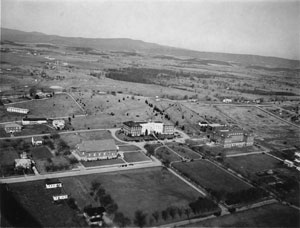
Aerial photo of the campus in the mid 1950s, looking west. Lehman Auditorium is at the lower left. The Ad Building, with its two annexes, is in the middle – note the parking and driveway directly in front. Northlawn is at right, with “X-Hall” behind it. On the hill above stands the observatory.
John L. Horst Jr., who played in the center’s inaugural basketball game, recalls being thrilled with his first experience on a regulation-sized gym floor where it was possible to dribble without bumping into spectators. At 6-foot, 4-inches, Horst was a standout, dunking and all, on one of the three highly competitive college-level sports teams formed around literary societies: the Smithsonians, Zelatheans, and Prometheans. By the mid-1960s these had given way to intercollegiate teams, made possible by the improved facilities.
Horst smiles at the memory of a board of trustees effort at rectitude in the new gym. “The board thought there should be a (moveable) divider in the gym, so that boys and girls (physical education) classes could be scheduled at the same time without seeing each other,” Horst recalled recently. “The board put up the money, and the panels were installed on a track, but they were almost never moved to block our view.”
A crash fundraising program marked 1959. EMC needed to raise endowment funds necessary for the college to be accredited by the Southern Association of Schools and Colleges. This accreditation was increasingly desired by students, for it helped them in transferring college credits and gaining admission to graduate schools. The majority of the campus 600 to 700 people acted as solicitors to reach 30,000 church members, as well as some businesses and foundations.
“The drive became exciting as it gathered momentum,” wrote Pellman. EMC had to have an endowment of $300,000. In the spring, endowment stood at $9,000. It hit $36,000 by June 15. On September 15, $65,000. A month later it had snowballed into $200,000. On November 5, the day before the deadline for meeting with the accreditation committee, EMC’s endowment stood at $275,000, still $25,000 short of the necessary amount.
At a restaurant 30 minutes before President Mumaw was scheduled to walk into a decisive meeting with accreditation authorities in Kentucky, he received a phone call from the executive director of the Association of American Colleges. “You got it!” Mumaw was told. EMC had been awarded the 4 th annual U.S. Steel Foundation grant. The amount of the award? $25,000.
It was not the first time, nor would it be the last, when administrators offered thanks for God’s beneficence at a critical juncture for EMC. The accreditation that EMU holds to this day among others was announced in December, 1959.
“It was very common for faculty and students to appeal for money,” said Kenton K. Brubaker, who responded to fundraising appeals from EMC while he was a doctoral student at Ohio State, 1954-59. When Brubaker re-joined EMC to teach science, he too acted as a fundraiser, soliciting contributions when needed. “For most of us, it was a very hard thing to do, but we did it.”
